When most people talk about using DNA for genealogy research, they are talking about autosomal DNA, which is DNA that one inherits from both parents. It can be challenging to use autosomal DNA for genealogy because the matching segments can come from either your father or your mother, and it’s hard to figure out which side. But with Y-DNA, you know exactly where it originates as it is passed only from father to son. The results can be useful to study the origin of surnames and to find families with different surnames who have common paternal ancestors.
Although Ancestry, MyHeritage, and 23andMe have all built enormous DNA databases that can be used for genealogy, they do not offer genealogically useful Y-DNA testing.
Of the firms that offer YDNA testing, the one with the largest Y-DNA database is familytreedna.com. Their basic Y-DNA 37-marker test costs $99 (when on sale), while the most detailed Y-DNA test, currently the Big Y-700, costs $379 (or less if you are upgrading from an existing FTDNA Y-DNA test). Men can test themselves and thereby identify their own paternal line.
But genealogists can use Y-DNA to learn about the paternal origins of other branches of their family by finding and testing a direct male descendant of their other ancestors. The key to this strategy is to find the right person to test.
A man’s Y-DNA test will give him the Y-DNA that comes from his father’s father. But what about his mother’s father? To learn his paternal ancestry, you will need to find a male descendant of one of his paternal ancestors. That can be as close as your grandfather’s brother (your great-uncle) or one of his direct male descendants (your cousins).. I tested my mother’s first cousin, the son of her father’s brother, to get the Y-DNA of my maternal grandfather.
The same process can be used to get Y-DNA from your other male ancestors. You just need to go up the tree to that ancestor and then trace back down on the male line in search of a male-line descendant. if you can find such a person, you can test for the Y-DNA signature that will help you learn more about the origins of that ancestral line.
Geni.com offers several tools that can help you find male-line descendants of your ancestors. Here are the methods I use to find people who can provide Y-DNA for my ancestors
Strategy A – Finding Y-DNA descendants to test using the Ancestor Report
Step 1: Generate an Ancestor Report. If you go to your profile page on Geni (which you can get to by clicking on your name in the upper right corner of your home screen and selecting View Your Profile), you can use the Actions menu button in the upper right to generate an Ancestor Report.

The Ancestor Report (which you can also generate from any profile on Geni, not just your own) allows you to see a nice display of all of your ancestors. You can adjust the number of generations it shows, up to twenty (which should be plenty).
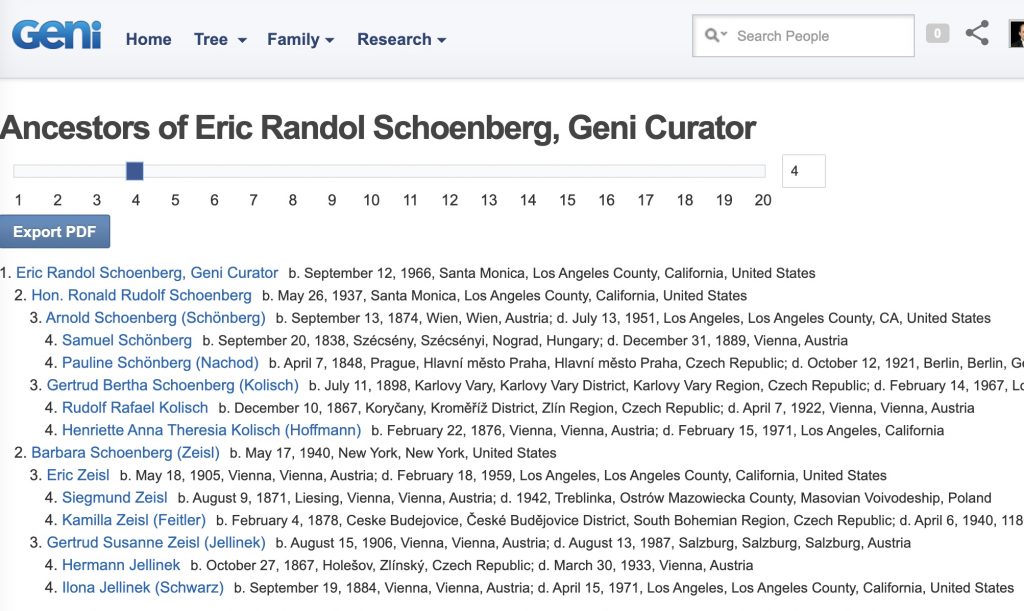
Step 2. Select an ancestor for whom you wish to find descendants to DNA test.
Let’s say I am looking for a Y-DNA descendant for my father’s mother’s father, Rudolf Rafael Kolisch in the example above. Because he isn’t on my paternal line, I need to find another person to test.
Step 3. Click the DNA Tab. Clicking on his name in the ancestor report will take me to his profile page. From there I scroll down until I see a row of tabs beginning with Overview. The last one is DNA.

Step 4. Click YDNA (Paternal search only) to find living descendants listed in Geni.com
When I click on the DNA tab I get a display with a number of different options. Note the one entitled Y-DNA (paternal line only). The blue hyperlink under the Y-DNA section says View a list of living people who can be tested for Y-DNA that should match Rudolf Rafael Kolisch. I want to click on that.
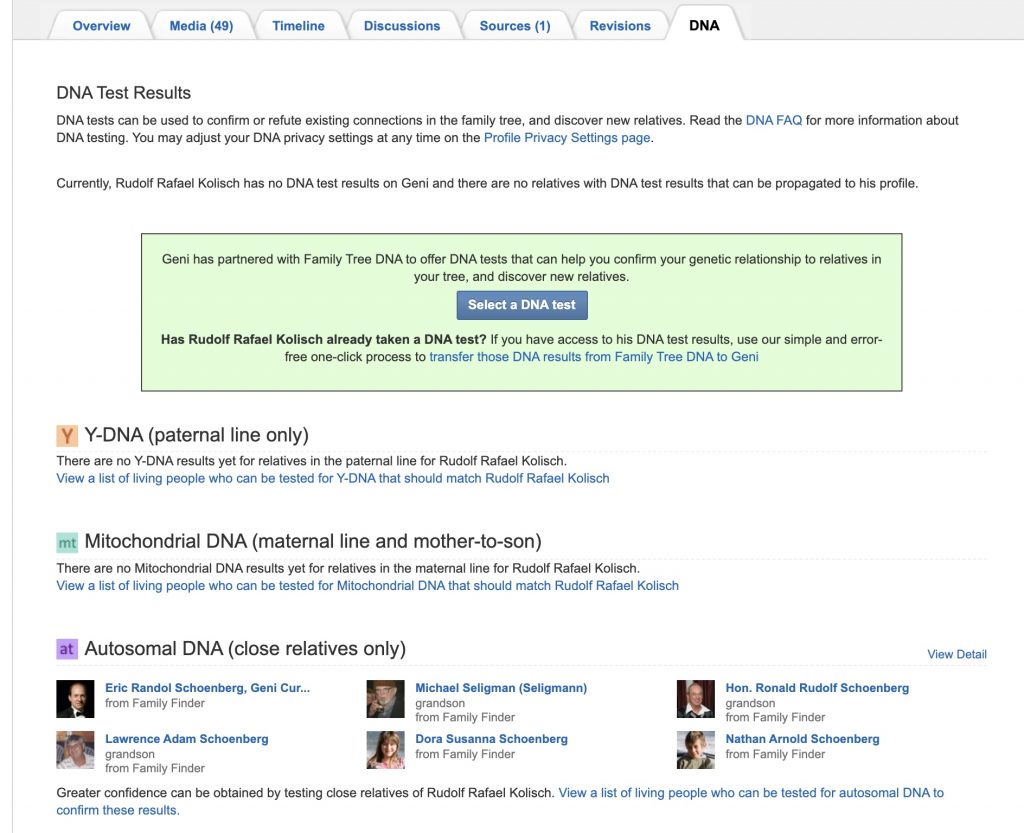
Step 5. Review the list of candidates for Y-DNA testing.
When I click on the blue hyperlinked text to view the people I can test, it takes me to a new page which lists the potential Y-DNA candidates. For my great-grandfather Kolisch, there is just one, my third cousin Petr Kolisch. He is the only male-line descendant of my great-grandfather Rudolf Rafael Kolisch, the only one in the family who can provide his Y-DNA.
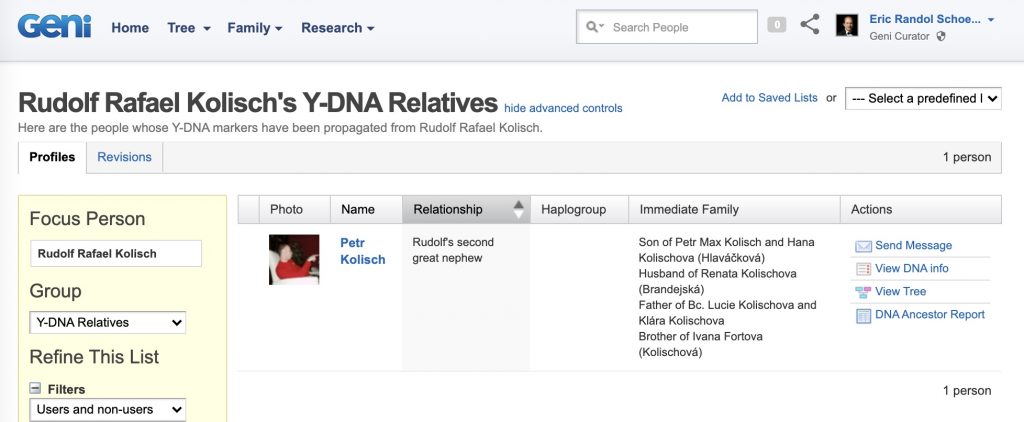
Strategy B – Finding relatives to test using the Lists function
Step 1. Click the Family tab, then the Lists tab.
You can actually get to this type of page from anywhere on Geni. All you have to do is click on the Family tab at the top of the page and select Lists.

Step 2: Choose the Focus Person, then “YDNA Relatives”, “Living” and “Users”
Once you are on the Lists page, you can use the advanced controls and choose the Focus Person, choose the Group Y-DNA Relatives, and Refine the List to just Living people to find potential Y-DNA relatives (not just descendants) of the Focus Person who could be tested. If you filter for Users only, you’ll get a list of Geni users who could be tested and you can easily click to send them a message asking if they are willing to take a Y-DNA test. (One tip: when selecting the focus person, sometimes it helps to use the profile id number, which is the long number in the url/internet address of the person’s profile page. So for example, my profile page is at https://www.geni.com/people/Randy-Schoenberg/6000000002764082210 and my profile id is 6000000002764082210.)
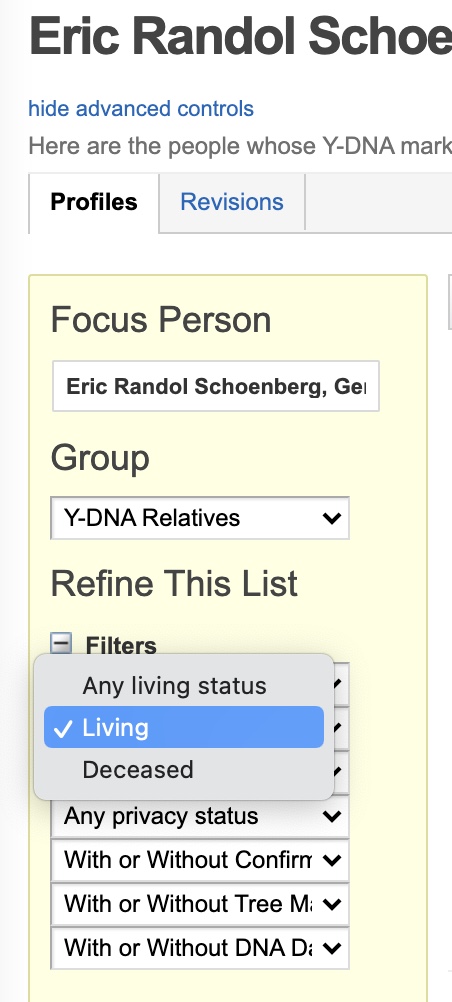
Step 3: Send a message to one or all of ancestor’s descendants in search of a candidate for DNA testing.
There are a few other tricks you can use on Geni. The first is to try to send a message to all of the Geni users who are descendants of an ancestor. First you go to your mailbox, which you get to by clicking on the little box next to the search field in the upper right and selecting Inbox Messages.

Then you click on Compose, the blue box over on the left.

Next, underneath the To: field there’s a row of options and the last one is Descendants of. Click on that.

It will ask you to type in the name of the profile, but you can also use the profile id number here, which may work better.

Once you have selected the profile, Geni will populate the address field with all of the Geni users who are descendants of the profile (up to a limit). This isn’t just the male-line descendants but it’s sometimes useful to cast a wide net and contact all of the descendants of your ancestor who are Geni users, in case one of them is in contact with a Y-DNA descendant who is not on Geni.
Finally, there are several ways to use descendant charts to find descendants. On Geni, similar to the Ancestor Report, you can use the Actions menu to create a Descendant Report for any profile.
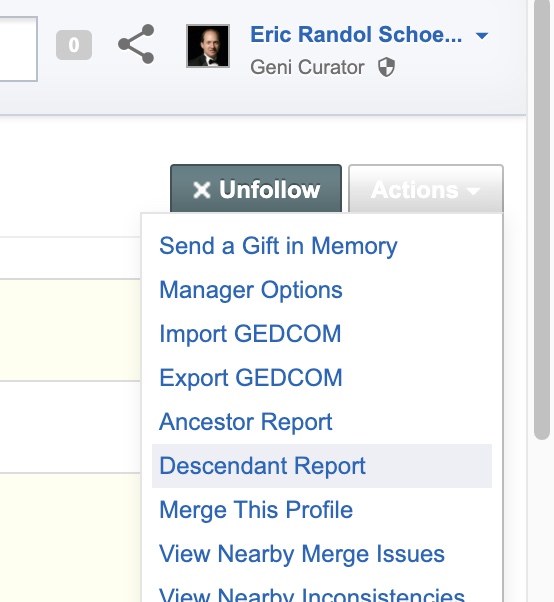
The Descendant Report is not limited to male line descendants but it can be very useful anyway, especially if there are male lines that still need to be developed. Often people leave off the living relatives on Geni and so you may need to identify those branches that still need to be explored and filled out.
There is also an application called HistoryLink created by a Geni curator, Jeff Gentes, which you can use to identify male-line branches and descendants. Go to https://historylinktools.herokuapp.com/ and click on Ancestor Graph in lower right corner.
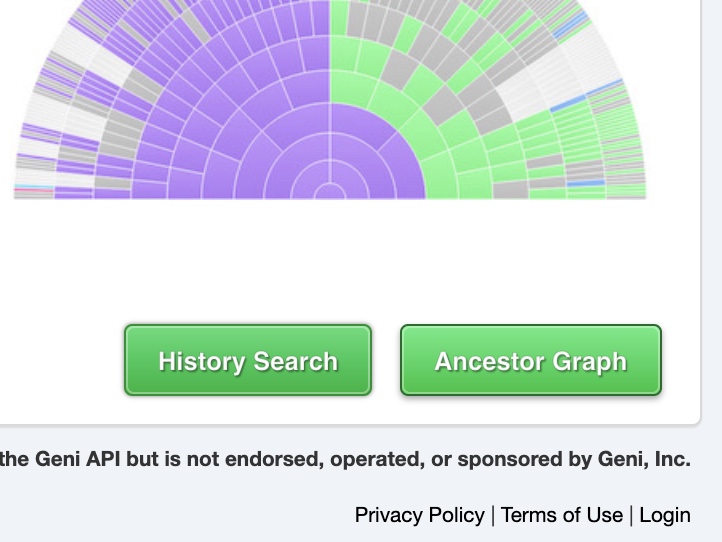
You’ll need to authorize the app (by logging into Geni if you aren’t logged in yet). It looks initially like it only creates an Ancestor graph, but you can change that to descendants. First change the focus person (once again having the profile id number is a real help), and then click to change Ancestors to Descendants. Then you can select the number of generations (up to 15 for a Descendant Graph) and you can even limit the results to just the male Y-DNA lines. Then click to Build Graph. It creates both a circular graph and an ordinary descendant chart with links to the Geni profiles. This technique is especially useful in identifying male lines from more distant ancestors that might still need to be built out so you can find a male line descendant to test.
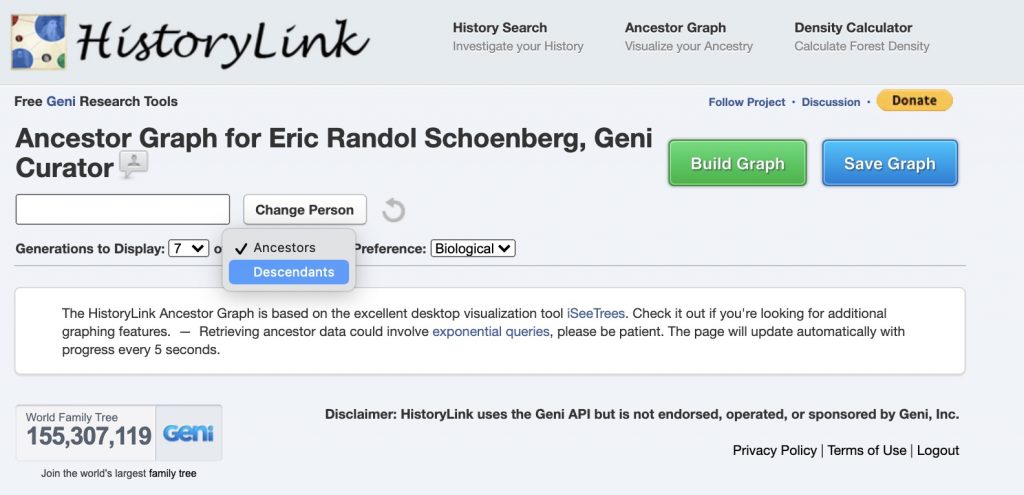
Using all of these techniques you can begin to collect Y-DNA samples from the male line descendants of each of your male ancestors. It’s a great way to learn something new, perhaps something deeper than what your ordinary paper-trail genealogy can tell you.
Postscript: If you are testing Jewish Y-DNA you should definitely join the Avotaynu DNA Project, which is an academic study of Jewish Y-DNA results.